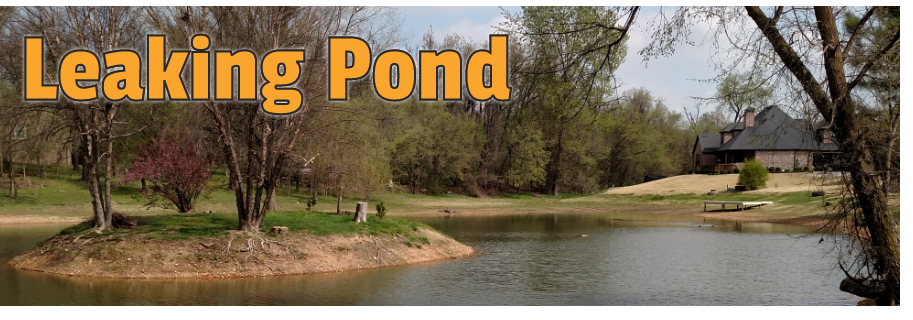Main Content

Pond water levels fluctuate in response to incoming and outgoing water. Natural factors that influence this cycle include rainfall, runoff, groundwater levels, seepage, and evaporation. During the heat of summer, it is not uncommon for Arkansas pond water levels to drop 1/2 inches per day from natural seepage and evaporation. Ponds dropping faster than this may be leaking through the pond basin, the dam, or both.
Most pond leaks are the result of mistakes made during construction from inexperience, cutting-corners to save time/money, or simple carelessness. Some leaks slip past even the most seasoned pond engineers following proper procedure. Parts of northern Arkansas are notorious for leaking ponds due to the rocky and soluble soils common to the area. In this region, following procedures explained in the
NRCS590 - Ponds - Planning, Design, Construction is critical to reduce the risk of leaks.
For ponds that are leaking, try to identify the source. Start by inspecting the outside of the dam for soft or wet spots. Stands of semi-aquatic plants can sometimes identify but conceal wet spots. Next, check around drain pipes for erosion around the outside of the pipe. Trees growing on dams can cause leaks as their roots penetrate clay layers and can establish routes for water to flow. Trees that are damaged, die, or are blown over during storms can be especially dangerous to the integrity of the dam. For these reasons, it is best to prevent woody vegetation growth from ever establishing on dams with regular mowing. Burrowing animals can dig holes through the dam and introduce routes of water flow. Finally, observe water levels closely during the summer and make note if the rate of water level drop declines or stops at a certain elevation. It is likely that the leak is located somewhere along the edge of the water at that elevation. However, it is also possible in this situation that the pond has simply dropped to the natural groundwater table and may still be leaking below the more consistent water elevation.
Locating a specific leak point helps increase the odds of successful repair. Even if the leak is located above the current water level, it may be necessary to partially, if not completely, drain the pond so that the soil moisture is right for good compaction during the repair. If a specific leak point is not located, it is usually best to completely drain the pond and rebuild the basin with the proper clay soil, and/or reinforce the soil with a sodium bentonite blanket. Bentonite treatments to undrained ponds can work, but the success rate is very low. Several publications below provide further specifics on repairing pond leaks and applying sodium bentonite. Contact your local
Natural Resources Conservation Service or
Cooperative Extension Service office if you need help locating contractors to complete the repairs.
Additional resources:
-
NRCS590 - Ponds - Planning, Design, Construction
-
SRAC 0104 Repairing Pond Levees
-
SRAC 0105 Renovating Leaky Ponds
-
A0704 Sealing Pond with Bentonite
-
Muskrats - Prevention and Control of Wildlife Damage